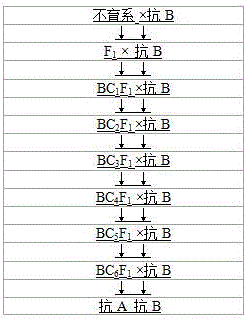Method for increasing disease-resistant breeding efficiency of hybrid rice
A hybrid rice, efficient technology, applied in the fields of botanical equipment and methods, biochemical equipment and methods, and microbial determination/inspection, etc. The effect of improving efficiency
- Summary
- Abstract
- Description
- Claims
- Application Information
AI Technical Summary
Problems solved by technology
Method used
Image
Examples
Embodiment 1
[0027] 1) Put Modan (with resistance to rice blast Pb-1 ) And CBB23 (carrying bacterial blight resistance gene Xa23 ) Hybridization, the offspring use with Pb-1 Gene and Xa23 Screening of gene-linked molecular markers to obtain Xa23 + Pb-1 ”Germplasm of chromosome fragments. The salt-tolerant mutant (carrying salt-tolerant gene sst , Obtained from R401 radiation) and Teqing (carrying resistance to rice blast Pi-tq1 ) Cross, the offspring use the same method to obtain the sst + Pi-tq1 ”Germplasm B of chromosome segment;
[0028] 2) Combine Yixiang 1B and 1) germplasm A ( Xa23 + Pb-1 ) To cross, get F 1 seed;
[0029] 3) Planting 2) F obtained 1 . When heading, take Yixiang 1B as the female parent, F 1 For the male parent, crossbreed, get BC 1 F 1 seed;
[0030] 4) Planting 3) BC obtained 1 F 1 seed. At the seedling stage, 120 individual plants resistant to bacterial blight were screened by Bacterial blight P6. After heading, 10 individual plants with other traits more consist...
Embodiment 2
[0047] 1) Longke 638S and Yixiangkang 2B obtained in Example 1 ( Xa23 + Pb-1 ) Hybrid, get F 1 seed;
[0048] 2) Plant F 1 , Late harvest, get F 2 seed;
[0049] 3) Planting 2) Income F 2 seed. In the seedling stage, the bacterial leaf blight fungus P6 was used to screen 1,000 individual plants resistant to bacterial blight. In the later stage, the fertility and agronomic traits were selected according to conventional breeding methods, and 100 sterile individual plants were obtained and self-bred to F 3 seed;
[0050] 4) Plant according to the plot 3) Income F 3 seed. In the seedling stage, the bacterial blight fungus P6 was used to screen 35 regions of bacterial blight resistant and non-segregating strains. In the later period, 30 strains were selected for agronomy, yield traits, and fertility by pedigree method, and self-bred F 4 seed;
[0051] 5) Planting 4) Income F 4 seed. In the seedling stage, the bacterial blight-resistant strain P6 was used to screen 30 areas of bacterial...
PUM
 Login to View More
Login to View More Abstract
Description
Claims
Application Information
 Login to View More
Login to View More - R&D
- Intellectual Property
- Life Sciences
- Materials
- Tech Scout
- Unparalleled Data Quality
- Higher Quality Content
- 60% Fewer Hallucinations
Browse by: Latest US Patents, China's latest patents, Technical Efficacy Thesaurus, Application Domain, Technology Topic, Popular Technical Reports.
© 2025 PatSnap. All rights reserved.Legal|Privacy policy|Modern Slavery Act Transparency Statement|Sitemap|About US| Contact US: help@patsnap.com

